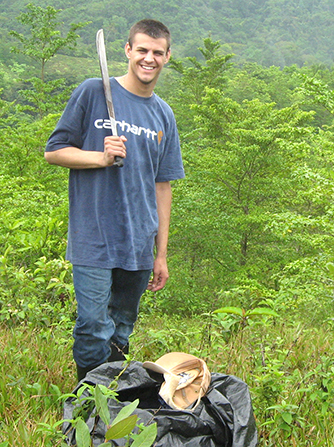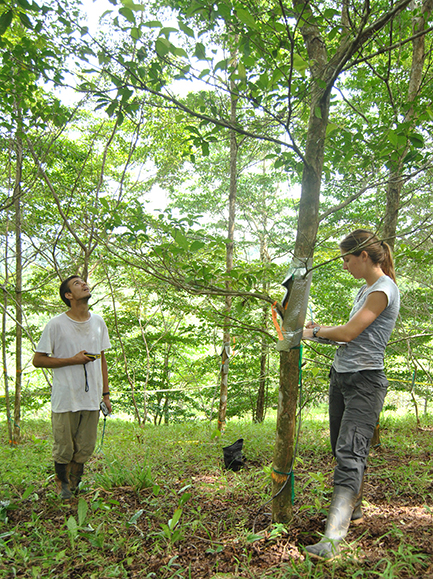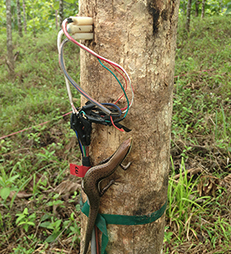Winter/Spring 2016
Earth Systems Science
AS A COLLEGE SOPHOMORE, when Connor Breton of Somersworth, N.H. found himself working in remote Panama alongside a colleague who spoke no English—and Breton knew just a few words of Spanish—he realized he was getting the bang for his UNH International Research Opportunities Program (IROP) buck.
 |
|
| Connor Breton with machete in Agua Salud, an experimental plantation within the Panama Canal Watershed. Photo by Katherine Sinacore. |
“What needed to get done did, but for both of us it required a lot of repeating and rephrasing of what you were trying to say—definitely on my part,“ says Breton now a senior with four years working in Heidi Asbjornsen's Earth System Research Center Ecohydrology Lab and two summers of fieldwork in Panama under his belt.
“Those are the tough situations where you learn the most, learn how to communicate effectively and how to be patient.”
And indeed, when you add complex science into the mix it becomes that much harder. How, for example, does one effectively explain "ecophysiology"—an experimental science that seeks to describe the physiological mechanisms underlying ecological observations—under such circumstances?
“A lot of times with things like that, and in this specific case the ecohydrology we study, you just shorten it to ‘water use’ or ‘water in the tree.’ There was a lot of simplifying. But by the end of this past summer, while I wasn’t always grammatically correct by any means, people pretty much understood what I was saying and vice versa,” Breton says.
Breton, who the summer after graduating from Somersworth High School contacted Asbjornsen about potential undergraduate research opportunities in her lab, has stayed the course through four years and came to realize he relished scientific fieldwork.
Says Asbjornsen, “When Connor approached me about working in the lab, I was immediately impressed by his enthusiasm for and commitment to forest ecology research—so it came as no surprise when he quickly expressed interest in our Panama project for his undergraduate research experience.” She adds, “There’s no doubt in my mind that his experience in Panama has had a huge life-changing impact on both his personal and professional growth.”
“Every summer since my freshman year I’ve been outside doing fieldwork both in the northern woods of New Hampshire and in Panama. Just being outside close to the environment I’m investigating has been really huge for me,” Breton says.
As an environmental science major who recently added a minor in forestry, Breton started off in the Asbjornsen lab building the sap flow equipment that measures how water moves through trees in ecosystems in an effort to determine, essentially, how much water a tree drinks. Scaling such measurements up, adding a few additional "whole tree physical measurements" and doing a bit of multiplication can tell scientists how much an entire forest drinks.
This “heat ratio” method uses three separate probes that are inserted into sapwood—one emits a pulse of heat while two others take temperature readings. With the raw temperature measurements recorded, the velocity at which water is flowing up the tree over a given time period can be calculated.
Says Breton, “The basic principal we’re looking at is the dissipation of heat as the water moves up the tree, from which we can eventually calculate how much water is moving through the tree over a period of time. That’s the primary work I do and it’s the foundation of the work I’ve been doing in Panama for these past two summers.”
Seeing the forest
Breton’s first experience using this equipment/method was in the Bartlett Experimental Forest in the White Mountains of N.H. while, for the past two summers, he’s been working with teak trees on the Agua Salud experimental plantation located within the Panama Canal Watershed. The site is approximately an hour outside of the capital of Panama City. His first summer in Panama was funded by a Smithsonian Tropical Research Institute internship with last summer’s work made possible by winning the IROP grant through the UNH Hamel Center for Undergraduate Research.
 | |
| Katherine Sinacore (background), team member Martyna Głodowska (foreground), and field dog Canela (right) sit to enjoy lunch on a scenic ridge of Agua Salud. Photo by Connor Breton. |
“Teak is known as a really good cash crop and they also use quite a bit of water.
My primary work is seeing how a fifty percent reduction in competition will change the way that water is moving through those trees or changing the physiological response of those trees to that reduction,” Breton explains.
“Understanding how these trees are using water and maybe how to better manage their physiological responses to certain conditions is important, especially in a country where you have a dry and wet season. Also, if local farmers are looking to plant teak, giving them the information that will help them grow big strong trees, trees they’ll get a nice return on or can meet specific ecosystem services they desire, can be very beneficial. A lot of the communities I worked in are pretty rural without a lot of money and economic advantage, so reaching out and talking with these landowners can be a very important part of what I do.”
 |
|
| Connor Breton (left) and Katherine Sinacore (right) take tree canopy measurements in a mixed species plot using a compass and laser to quantify canopy structure. Photo by Eduardo Sanchez. |
Breton adds, “I’d like to provide kind of a silvicultural prescription for the best way to plant some of these teak trees and how they can be used for a desired outcome.”
 |
|
| A lizard found relaxing and cooling down beneath the solar radiation shield of a teak tree. Photo by Connor Breton. |
Breton notes that Ph.D. student Katherine Sinacore, also working in the Asbjornsen lab, has been conducting her research for the past two years in Panama looking at interactions between native species in the Agua Salud planation. Sinacore uses the same heat ratio method as Breton and has provided invaluable support and assistance.
“She’s helped me every step of the way—writing grants, setting up my experiment, and now she’s assisting with work on the data. I couldn’t be more thankful,” Breton says.
What drew him to the Asbjornsen ecohydrology lab in particular was his interest in climate change at the time—an interest he still maintains but which has become more focused during his four years of research and coursework, including picking up a minor in forestry last year.
“My interests have always been pretty broad and through taking classes like forest ecology I discovered that forestry might be a good way to connect all my interests and experiences—from climate change to the ecohydrology work—and use it to manage the trees of the forest, wildlife habitat, carbon sequestration, etcetera. My dream job would be being the forester for projects that are trying to do non-timber resource management,” he says.
And he hopes to do that in the temperate forests of New England in order to stay close to home.
“I’m a pretty family-oriented person and I have a large family with everyone either in New Hampshire or Maine so I would like to go to graduate school in New England and stay in the region long term.”
He adds, “The ecohydrology lab has offered me so much. They have gone above and beyond to support me and invest their time, money, and energy in me and I really like the fact that I’m able to see my work go all the way from building the sensors to implementing them in the field and, at this point, working on the data analysis. That’s been really rewarding for me. How many people can say they’ve had the opportunity to travel internationally for two summers in a row and do their own scientific research project? I’ve been very lucky.”
“Connor is one of the most motivated, independent, and talented undergraduate students to have come through my lab, and it’s been a pleasure watching him explore his interests and discover a passion for research,” Asbjornsen notes. “One of my goals as a professor at UNH is to provide more undergraduate students with international research opportunities similar to Connor’s, and UNH’s IROP program is an incredible resource to support students interested in taking advantage of such opportunities.”